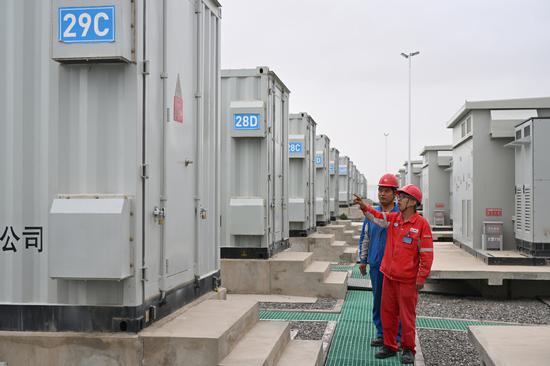Xinjiang standing tall in renewable projects
Northwest China's Xinjiang Uygur autonomous region's energy storage capacity is accelerating at an unprecedented pace, fueled by a boom in renewable energy projects that position the region as a pivotal player in China's green transition.
With large-scale investments in wind, solar and cutting-edge storage solutions, Xinjiang is rapidly expanding its energy storage infrastructure, which is expected to near 10 million kilowatts by the end of 2024, according to the State Grid Xinjiang Electric Power Co Ltd's Economic and Technical Research Institute.
This growth not only bolsters energy security, but also sets the stage for a more resilient and sustainable energy grid that can balance the region's vast renewable output, said Li Changling, deputy head of the energy development research center under the institute.
"This expansion would position Xinjiang as the leader in installed storage capacity nationwide, as China's energy storage sector is on the brink of significant expansion as it transitions to a low-carbon energy system," said Li during a recent seminar on energy storage development in Beijing.
As Xinjiang is expected to add 100 gigawatts of new renewable capacity during the 14th Five-Year Plan period (2021-25), the utilization rate for these new energy sources could fall below 68 percent without effective measures such as energy storage, he said.
While power generation from renewable sources is projected to reach 118 billion kilowatt-hours in 2024 — a year-on-year increase of 33 percent — overall electricity consumption is expected to grow at a slower pace, reaching 380 billion kWh with a growth rate of 10 percent, Li said, warning that "the discrepancy highlights a growing imbalance between renewable generation and power demand, underscoring the challenges in effectively integrating renewable energy into the grid".
According to the institute, Xinjiang's renewable energy sector is entering a rapid acceleration phase as large-scale energy projects in the region take off. Driven by robust development efforts, the region's grid-connected renewable capacity is forecast to surpass 100 GW by the end of 2024, making renewables Xinjiang's leading power source.
According to the National Energy Administration, as of August, Xinjiang's total installed power capacity reached 165 GW, with renewables now dominating the region's energy mix. Coal-fired power accounted for 72.75 GW, while renewable sources — including wind and solar — totaled 81.45 GW, making up 49.5 percent of the capacity.
Wind power contributed 38.23 GW, and solar 43.23 GW. Hydropower, including 1.2 GW from pumped storage, provided 10.78 GW, representing 6.5 percent of the total, it said.
The expansion of renewable energy power generation brings both opportunities and challenges, said Li, as the pace of growth and the highly similar generation patterns across wind and solar plants contribute to high variability, creating supply-demand balancing uncertainties for the grid.
This allows energy storage to play a key role in balancing renewable integration with grid stability, he said.
According to the institute, integrated energy storage with renewables, or the storage systems built alongside or in conjunction with renewable energy projects, currently play a dominant role in China's renewable energy sector, accounting for 98.64 percent of the country's total energy storage capacity, while independent storage represents just 1.36 percent.
Within integrated energy storage systems, solar projects make up 65.1 percent, while wind projects contribute 34.9 percent, it said.
Lithium iron phosphate batteries continue to be the primary choice, comprising 98.82 percent of the storage capacity, underscoring the preference for reliable and efficient energy storage technologies in the sector.
Lin Boqiang, head of the China Institute for Studies in Energy Policy at Xiamen University, pointed to advances in battery technology, grid upgrades and supportive government policies as key drivers that could position China as a global leader in energy storage solutions.
On the other hand, the country also faces a growing imbalance between renewable capacity and available adjustment resources. As of now, a total of 255 GW of renewable energy projects have been approved, reaching five times the original target set in the 14th Five-Year Plan. Renewable capacity will be 3.3 times the available adjustment resources, highlighting a critical need for balancing solutions to manage the influx of renewable energy effectively, Lin said.
Li suggested continuing to promote the standardization and regulation of the energy storage industry, come up with new energy storage policies to guide market development, create a favorable market environment, and provide strong support for the advancement of new energy storage technologies.
According to the institute, Xinjiang has been stepping up efforts to diversify its storage technologies in recent years.
Compressed air, flywheel and gravity storage systems are progressively coming online, indicating a multifaceted, application-rich approach to energy storage while highlighting Xinjiang's role in pioneering varied energy storage solutions as part of China's transition to a renewable-powered future, it said.

